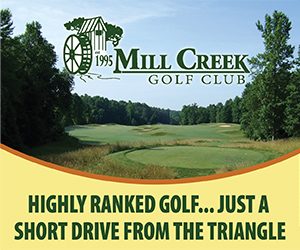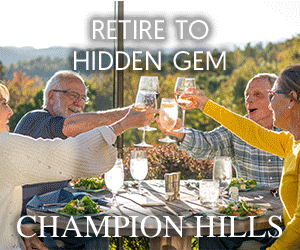By DAVID DROSCHAK
We’ve grown accustomed to golf industry rhetoric promising playable courses and timely rounds, only to be faced with a half-dozen lost Titleists and over-crowded layouts, prompting repeated calls to the wife pleading our innocence as 18 holes stretches into a fifth hour.
Having headed to The Heritage Golf Club in Wake Forest for just my second round of 2010 a few weeks ago, I was indeed skeptical that I could meet my required golfing check-list of playing fast, having fun and recording a score I was somewhat unabashed of once completed.
Teeing it up with course architect Bob Moore and Heritage general manager John Spiess, I am here to say all goals were met as I avoided all 115 bunkers, didn’t lose a ball and carded an 84.
And that score would have been better had my 20-year-old stepson not left my putter in his bag – and in my garage – after borrowing it for some night golf over the weekend.
Since I live in Apex, I don’t travel to the northern part of Wake County as much as I used to, but playing The Heritage and partaking in some of its fine cuisine for lunch (I recommend the fried chicken or pork loin) made me realize just how much I miss arguably the Triangle’s best semi-private golf experience and why the layout was voted the best new course in North Carolina nine years ago.
I’m here to testify Moore’s layout remains a solid, fair test of golf without beating you over the head, especially if you can avoid his self-proclaimed “American-style” pot bunkers that frame most landing areas and tempt a long hitter to cut some corners.
If you’re into variety, The Heritage has a little bit of everything – rolling hills, reachable par-5s, water holes, rocks walls and more than one picturesque signature hole.
Like the 154-yard 12th hole, which tests a golfer’s accuracy with a short iron over water to a narrow green held in place by dozens of boulders Moore uncovered on the former dairy farm. Other golfers favor the finishing par-5 as the best, with its drive over water, 14 strategically placed bunkers and a lake fountain that lights up at night.
What’s more important is the course fits into the land like a glove. Of course, like many top-notch golf designs and developments, there is a story behind the successful harmony of holes and homes.
While Moore gets a lion’s share of the credit for the playability of the course, it was the visionary eyes of developer Jud Ammons who ended up bringing this thriving Raleigh bedroom community to life.
The developmental plans for The Heritage actually began in the mid 1980s when a large tract of land – the former Marshall-Stroud Dairy Farm – was purchased by Ammons. Without many trees, Ammons and his sons set out to enhance the character of the property with one eye on the future product – The Heritage golf course and community – which helped spearhead the growth boom of the former sleepy town of Wake Forest over the last decade.
Andy Ammons, one of Jud’s sons, tells the story of how the family and workers spent three years planting more than one million pine seedlings throughout the property, hunted and fished there, and watched the trees mature over time into a pine forest that rivals anything in Pinehurst.
“We planted 600 acres of pine trees and then we had to clear about 150 of that back for the golf course,” Andy Ammons said. “Indirectly, that became the biggest asset we have. We have a pine tree buffer around the whole golf course so all of our homes have a 20-30 foot buffer that the homeowner can’t touch and the golf course has a 20-30 foot buffer that they can’t touch.”
“Without the pine trees, without the forest, we would have been almost forced into wider corridors for the golf course,” added Moore. “Jud Ammons’ vision in planting those pines long before the golf course was developed was just brilliant.”
Jud Ammons tapped a young Moore to design Nags Head Golf Links along the Outer Banks in the late 1980s, so another golf community collaboration between the two more than a decade later was a perfect match.
“The best thing we did was we let Bob have full reign of the land to start with,” Andy Ammons said. “He knew we had to sell some houses to afford what he wanted to do and we knew he needed certain pieces of land for what he needed to do, so we understood that going in.”
The beginning process of the golf course was a bit painful for Andy Ammons to watch as acres of trees, many of which he personally planted, were plowed down for green fairways.
“For 15 years we watched trees grow, we hunted out here,” Ammons said. “I can tell you different animals I hunted on different spots of the property and my brother fished the ponds a whole lot. We got to know the land and feel comfortable with it and we became very attached to the land. But becoming emotionally attached to a piece of land is not a good in our business because you don’t always make decisions from a business point of view, you do it on emotion.”
You can hear the pride in Ammons’ voice when he talks about the development of not only The Heritage Golf Club, but the surrounding community, which now totals more than 2,000 acres.
Despite difficult economic times, the club is thriving with an active membership, extensive junior programs and golf leagues, two large swimming pools, parks and nearby schools. And homes are still going up.
And head pro David Sykes, the son of N.C. State golf coach Richard Sykes, has been in place from the start.
“David just adds so much credibility and stability to our entire organization here,” Spiess said. “He’s seen the very first house going up here and has seen the golf course mature.”
The Ammons group even took the time to meet with community leaders in Wake Forest and local Chamber of Commerce members prior to development, seeking input to try and get the proper feeling for the community.
“We picked out 15 leaders and gave them some disposable cameras and asked them to take 25 pictures each of downtown Wake Forest and what makes Wake Forest a great place and we brought them all together,” Ammons said. “We had a selection of about 300 photos of what people thought of Wake Forest and used certain items throughout our community. We weren’t trying to build a small town, we were tying to expand on one and improve on one.”
While Heritage has won numerous awards for its golf course, the club has not rested on its laurels. The entire clubhouse has been renovated within the last two years, and the 1250 Heritage restaurant has a county club atmosphere with a fire place and stunning wraparound outside deck.
“I see people walking in the front door frequently and say, ‘Are you sure this isn’t a private club?’ Our presentation is how we are perceived,” said Tami Bright, the club’s membership and marketing director. “And it starts with our staff.”
“Our restaurant is a bistro style concept with a great chef,” added Spiess. “We want to create a certain atmosphere for our membership and the public. We can sit over 100 people on our deck and at night with the fountain lighted it’s just fabulous – and something you can’t find anywhere else in the Triangle.”
The Heritage is blessed with history and tradition, and progressive thinking leadership, which has enhanced an already impressive product.
“Our family has been doing this for many years so you learn how to look ahead a little bit and try to begin with an end in mind,” Andy Ammons said. “It was the land of the Indians, then it became the land of farmers and now it is our land, and we’re passing it along to the people who live here.”

















